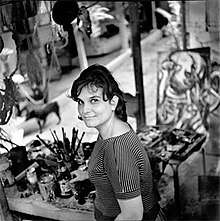Antonia Eiriz
Antonia Eiriz Vázquez (1929–1995)[2] was a Cuban painter whose work was exhibited throughout Latin America during her life. She was born in Havana, Cuba in the neighborhood of Juanelo and was the youngest of six children. When she was young, she developed skills in sewing, knitting, and crafting. Eiriz also had polio when she was very young, and thus had to live with a disability for the rest of her life.[3] She began her studies of fine arts at the Escuela Nacional de Bellas Artes "San Alejandro" in 1953. While there, she exhibited her work with artists that would become known as Los Once ("the group of eleven"), one of whom, Guido Llinás, would become a close friend and mentor.[4] She also contributed illustrations to the magazine, Lunes, edited by Guillermo Cabrera Infante, which was a supplement of the newspaper, Revolución.[5] In 1964, she held three solo shows (two in Cuba and one in Mexico), in which she would position herself as "one of the strongest voices in the art landscape of Cuba"[6]. Eiriz taught painting until 1968, when her work, Una tribuna para la paz democratica ("a platform for democratic peace"), was deemed "defeatist" by the Cuban government, which effectively marked her as a dissident.[4] She abruptly ceased painting that year and withdrew from artistic circles, thereafter devoting her life and talents to Cuban crafts.
Antonia Eiriz Vázquez | |
|---|---|
 | |
| Born | April 1, 1929 Havana, Cuba |
| Died | March 9, 1995 (aged 65) Miami, Florida |
| Nationality | Cuban |
| Education | San Alejandro National School of Fine Arts[1] |
| Known for | Painting |
| Awards | National Culture Award (1981) Alejandro Carpenter Medal (1983) |
In 2001 Antonia's work was displayed in the National Museum of art in Cuba and can still be seen to this day. Eiriz received a National Culture Award in 1981, and in 1983 received the Alejandro Carpenter Medal.[2] In 1989 the Cuban government awarded her the Félix Varela Order; in 1994 she was the recipient of a Guggenheim Fellowship.[1] Eiriz moved to the United States in 1993, where she returned to painting and lived the final two years of her life in Miami, Florida. Eiriz had finished over 25 large oil format paintings before her passing.[5]
References
- Gomez, Manuel. "Biography Antonia Eiriz April 1, 1929 — March 9, 1995". A n t o n i a E i r í z. Retrieved 17 August 2017.
- "Antonia Eiriz". Cubarte. Retrieved 17 August 2017.
- contributor., Fajardo-Hill, Cecilia, contributor. Giunta, Andrea, contributor. Alonso, Rodrigo (2017). Radical women : Latin American art, 1960-1985. ISBN 9783791356808. OCLC 982089637.
- Radical women : Latin American art, 1960-1985. Fajardo-Hill, Cecilia,, Giunta, Andrea,, Alonso, Rodrigo,, Armand Hammer Museum of Art and Cultural Center,, Brooklyn Museum,, Pacific Standard Time: LA/LA (Project). Los Angeles: Hammer Museum. 2017. p. 325. ISBN 9783791356808. OCLC 982089637.CS1 maint: others (link)
- Anreus, Alejandro (2004). "The Road to Dystopia: The Paintings of Antonia Eiriz". Art Journal. 63 (3): 4–17. doi:10.2307/4134487. JSTOR 4134487.
- contributor., Fajardo-Hill, Cecilia, contributor. Giunta, Andrea, contributor. Alonso, Rodrigo (2017). Radical women : Latin American art, 1960-1985. ISBN 9783791356808. OCLC 982089637.
- Veerle Poupeye. Caribbean Art. London; Thames and Hudson; 1998.